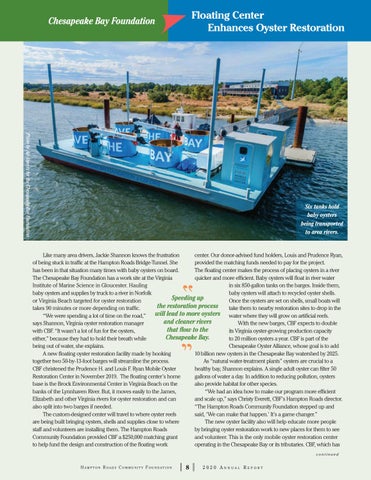Floating Center Enhances Oyster Restoration
Chesapeake Bay Foundation
Photo by Air Aspects for the Chesapeake Bay Foundation
Six tanks hold baby oysters being transported to area rivers.
Like many area drivers, Jackie Shannon knows the frustration center. Our donor-advised fund holders, Louis and Prudence Ryan, of being stuck in traffic at the Hampton Roads Bridge-Tunnel. She provided the matching funds needed to pay for the project. has been in that situation many times with baby oysters on board. The floating center makes the process of placing oysters in a river The Chesapeake Bay Foundation has a work site at the Virginia quicker and more efficient. Baby oysters will float in river water Institute of Marine Science in Gloucester. Hauling in six 850-gallon tanks on the barges. Inside them, baby oysters and supplies by truck to a river in Norfolk baby oysters will attach to recycled oyster shells. Speeding up or Virginia Beach targeted for oyster restoration Once the oysters are set on shells, small boats will the restoration process takes 90 minutes or more depending on traffic. take them to nearby restoration sites to drop in the will lead to more oysters water where they will grow on artificial reefs. “We were spending a lot of time on the road,” and cleaner rivers says Shannon, Virginia oyster restoration manager With the new barges, CBF expects to double that flow to the with CBF. “It wasn’t a lot of fun for the oysters, its Virginia oyster-growing production capacity Chesapeake Bay. either,” because they had to hold their breath while to 20 million oysters a year. CBF is part of the being out of water, she explains. Chesapeake Oyster Alliance, whose goal is to add A new floating oyster restoration facility made by hooking 10 billion new oysters in the Chesapeake Bay watershed by 2025. together two 50-by-13-foot barges will streamline the process. As “natural water-treatment plants” oysters are crucial to a CBF christened the Prudence H. and Louis F. Ryan Mobile Oyster healthy bay, Shannon explains. A single adult oyster can filter 50 Restoration Center in November 2019. The floating center’s home gallons of water a day. In addition to reducing pollution, oysters base is the Brock Environmental Center in Virginia Beach on the also provide habitat for other species. banks of the Lynnhaven River. But, it moves easily to the James, “We had an idea how to make our program more efficient Elizabeth and other Virginia rivers for oyster restoration and can and scale up,” says Christy Everett, CBF’s Hampton Roads director. also split into two barges if needed. “The Hampton Roads Community Foundation stepped up and The custom-designed center will travel to where oyster reefs said, ‘We can make that happen.’ It’s a game changer.” are being built bringing oysters, shells and supplies close to where The new oyster facility also will help educate more people staff and volunteers are installing them. The Hampton Roads by bringing oyster restoration work to new places for them to see Community Foundation provided CBF a $250,000 matching grant and volunteer. This is the only mobile oyster restoration center to help fund the design and construction of the floating work operating in the Chesapeake Bay or its tributaries. CBF, which has continued
Hampton Roads Community Foundation
8
2020 Annual Report
